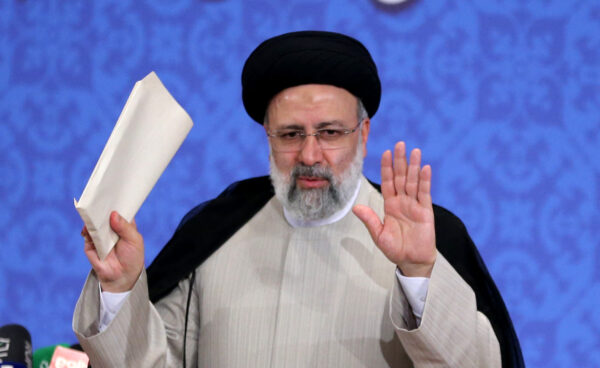


Iranian President Ebrahim Raisi arrived in Damascus on May 3, where he signed a “strategic cooperation” agreement with his Syrian counterpart, Bashar al-Assad.
Raisi’s two-day visit to Damascus is the first trip to Syria by an Iranian head of state since 2011, when protests against Assad and his government rapidly escalated into full-blown civil conflict.
Raisi is accompanied on the trip by a high-ranking delegation that also includes the Iranian ministers of foreign affairs, defense, energy, and telecommunications.
Soon after Raisi’s arrival, the two leaders held plenary talks at Assad’s presidential palace in Damascus, according to Syria’s SANA news agency.
“Syria-Iran relations have remained firm despite severe political and security challenges that engulfed the Middle East,” SANA quoted Assad as saying at the meeting.
Raisi responded by saying that Syria had “surpassed all these difficulties and achieved victory, despite the threats and sanctions imposed on you.”
According to the news agency, the two leaders signed a raft of bilateral agreements, including one for “long-term strategic cooperation” between the two countries.
During the first years of the Syria conflict, much of the country fell under the sway of “rebel” groups—Damascus calls them “terrorists”—backed by the West, Turkey, and the Arab Gulf States.
But since 2015, the Syrian government, with Russian and Iranian help, has managed to reassert control over most Syrian territory.
However, the United States and its local allies–the self-styled “Syrian Democratic Forces”–still maintain a sizeable military presence in northeastern Syria.
According to Washington, this military presence, which includes roughly 900 U.S. troops, is necessary to prevent the resurgence of the ISIS terrorist group.
Said to be an Al-Qaeda offshoot, ISIS overran broad swathes of Syria—and Iraq—in 2014. It was largely eradicated by 2019, prompting then-President Donald Trump to withdraw most U.S. troops from Syria.
NATO member Turkey, meanwhile, maintains a presence in the country’s northwest, which it says is needed to safeguard its border from Kurdish militant groups.
Damascus and Tehran both regard the continued presence of U.S. and Turkish forces as “illegal occupations” and have repeatedly called for their departure from Syrian territory.
On the eve of his trip to Damascus, Raisi described Iran-Syria relations as “deep and strategic,” adding that his visit aimed to further consolidate ties.
He also stressed Tehran’s readiness to help rebuild Syria’s shattered infrastructure following more than a decade of conflict.
“This process should begin as soon as possible, as displaced persons return to their country and normal conditions [in Syria] are reestablished,” Raisi said in televised comments cited by Iran’s IRNA news agency.
Noting that Iran had backed Syria throughout the conflict, Raisi claimed that the United States and Israel had “hoped Syria would collapse and that they would break the frontline of the resistance.”
Israel carries out frequent attacks on Syrian territory, which it claims target Iranian military assets deployed in the country.
In February, an Israeli rocket attack near Damascus reportedly killed several Iranian military experts.
Since its establishment in 1948, Israel—long seen as a key U.S. ally—has fought three major conflicts with Syria.
Israel and Syria have never had diplomatic relations and technically remain in a state of war.
With Assad now firmly ensconced in power, several regional countries that had previously shunned Damascus are now calling for reconciliation.
On May 1, the foreign ministers of Egypt, Iraq, Saudi Arabia, and Jordan met their Syrian counterpart to draw up a “roadmap” for ending the 12-year-old conflict.
Held in the Jordanian capital Amman, the meeting also discussed means of reestablishing diplomatic ties between Damascus and several Arab capitals.
It was the first such meeting since 2011 when the Cairo-based Arab League agreed to suspend Syria’s membership in the pan-Arab organization.
Last month, the Syrian and Saudi foreign ministers agreed to resume consular services and commercial flights between their countries.
In March, Riyadh agreed to resume diplomatic ties with Tehran—in a deal brokered by Beijing—following a seven-year hiatus.
Turkey also hopes to reconcile with Syria after more than a decade of mutual hostility.
Next week, the Turkish, Syrian, and Iranian foreign ministers will meet in Moscow for landmark talks, Turkey’s top diplomat said on May 3.
It is hoped that the Moscow-hosted talks will lead to an eventual summit between Assad and Turkish President Recep Tayyip Erdogan.



